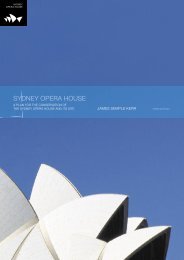nomination by the Government of Australia - Sydney Opera House
nomination by the Government of Australia - Sydney Opera House
nomination by the Government of Australia - Sydney Opera House
You also want an ePaper? Increase the reach of your titles
YUMPU automatically turns print PDFs into web optimized ePapers that Google loves.
Utzon’s reading and use <strong>of</strong> historical forms, particularly those <strong>of</strong> ancient China, is a<br />
clue to his originality. In <strong>Sydney</strong>, <strong>the</strong>se diverse facets seemed to unfold, to expand,<br />
and find <strong>the</strong>ir expression in a unique syn<strong>the</strong>sis driven <strong>by</strong> a process <strong>of</strong> conceptual<br />
invention, undertaken in a state <strong>of</strong> grace (Françoise Fromonot 2000: 7–8).<br />
With <strong>the</strong> demise <strong>of</strong> <strong>the</strong> classical language <strong>of</strong><br />
architecture as <strong>the</strong> basis for monumental works<br />
that express civic values after World War II, <strong>the</strong><br />
<strong>Sydney</strong> <strong>Opera</strong> <strong>House</strong> is <strong>the</strong> culmination <strong>of</strong> <strong>the</strong><br />
search for an alternative means <strong>of</strong> expression<br />
that had preoccupied progressive architects<br />
since <strong>the</strong> 1920s (Goad 2005).<br />
Utzon’s design was inspired <strong>by</strong> an eclectic suite <strong>of</strong> ideas<br />
from ancient through to modern times that included<br />
Mayan, Japanese, Chinese, Indian, Islamic and western<br />
cultures. The infl uence <strong>of</strong> <strong>the</strong> ancient Mayan steppyramids<br />
in Mexico on <strong>the</strong> podium <strong>of</strong> <strong>the</strong> <strong>Sydney</strong> <strong>Opera</strong><br />
<strong>House</strong> and <strong>the</strong> analogy <strong>of</strong> Chinese temples with <strong>the</strong>ir<br />
‘fl oating’ ro<strong>of</strong>s is well documented. Utzon’s use <strong>of</strong> ideas<br />
borrowed from o<strong>the</strong>r places and times is also apparent<br />
in many o<strong>the</strong>r aspects <strong>of</strong> <strong>the</strong> design.<br />
The site resembles <strong>the</strong> A<strong>the</strong>nian Acropolis to <strong>the</strong><br />
extent that <strong>the</strong> ‘artifi cial landform … becomes <strong>the</strong><br />
site—surmounted <strong>by</strong> two great “temples” ’ (Weston<br />
2002: 114). Several architectural historians have<br />
highlighted Utzon’s genius in making <strong>the</strong> architecture<br />
and landscape appear as one (Moneo 2004: 88). The<br />
use <strong>of</strong> tiling on <strong>the</strong> shells was inspired <strong>by</strong> <strong>the</strong> glistening<br />
domes and minarets rising above Islamic villages<br />
and also <strong>by</strong> Utzon’s studies in <strong>the</strong> art <strong>of</strong> Chinese and<br />
Japanese ceramics (Weston 2002: 148, 184–186).<br />
Utzon’s construction methods incorporated insights<br />
from <strong>the</strong> 12th century Chinese treatise Ying Zao fa<br />
shi, which advocated <strong>the</strong> assemblage <strong>of</strong> prefabricated<br />
components and informed his <strong>the</strong>ory <strong>of</strong> ‘Additive<br />
Architecture’ (Weston 2002: 186; Goad 1997: 139).<br />
Figure 3.10 Clouds over <strong>the</strong> sea, Jørn Utzon, 1962<br />
Figure 3.11 Sketch <strong>of</strong> a Japanese house, Jørn Utzon, 1962<br />
3.10<br />
3.11<br />
3.12<br />
3.13<br />
Figure 3.12 Preliminary sketch for <strong>the</strong> vaults <strong>of</strong> <strong>the</strong> <strong>Sydney</strong><br />
<strong>Opera</strong> <strong>House</strong>, 1958<br />
Figure 3.13 Concept sketch for <strong>the</strong> <strong>Sydney</strong> <strong>Opera</strong> <strong>House</strong>,<br />
1958<br />
33

















